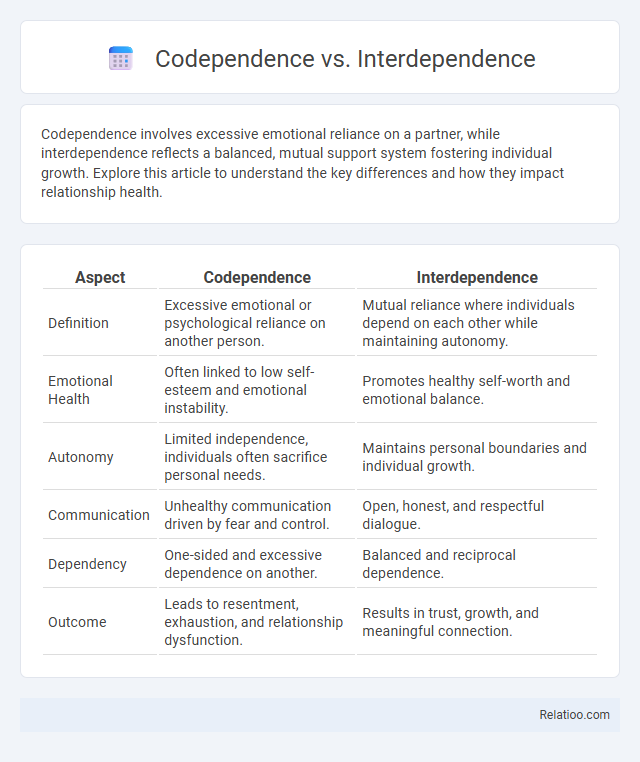Codependence involves excessive emotional reliance on a partner, while interdependence reflects a balanced, mutual support system fostering individual growth. Explore this article to understand the key differences and how they impact relationship health.
Table of Comparison
| Aspect | Codependence | Interdependence |
|---|---|---|
| Definition | Excessive emotional or psychological reliance on another person. | Mutual reliance where individuals depend on each other while maintaining autonomy. |
| Emotional Health | Often linked to low self-esteem and emotional instability. | Promotes healthy self-worth and emotional balance. |
| Autonomy | Limited independence, individuals often sacrifice personal needs. | Maintains personal boundaries and individual growth. |
| Communication | Unhealthy communication driven by fear and control. | Open, honest, and respectful dialogue. |
| Dependency | One-sided and excessive dependence on another. | Balanced and reciprocal dependence. |
| Outcome | Leads to resentment, exhaustion, and relationship dysfunction. | Results in trust, growth, and meaningful connection. |
Understanding Codependence: Key Characteristics
Codependence is characterized by an excessive emotional or psychological reliance on a partner, often leading to unhealthy relationship dynamics where Your self-worth depends on others' approval. Unlike interdependence, which involves mutual support and healthy boundaries, codependence features patterns of enabling, low self-esteem, and difficulty asserting personal needs. Recognizing these key characteristics helps in distinguishing codependence from balanced interdependence and fosters personal growth.
Defining Interdependence: Core Principles
Interdependence is defined by mutual respect, trust, and balanced support between individuals, fostering personal growth and healthy relationships. Unlike codependence, which involves excessive reliance and control, interdependence promotes autonomy while maintaining strong emotional connections. Understanding these core principles helps you cultivate partnerships based on equality and shared responsibility.
Emotional Boundaries: Codependence vs Interdependence
Emotional boundaries in codependence are often blurred, leading to excessive reliance on others for self-worth and emotional stability, which undermines personal autonomy. In contrast, interdependence maintains healthy emotional boundaries by allowing individuals to receive support while preserving their own identity and emotional regulation. This balanced approach fosters mutual respect and resilience within relationships.
Communication Styles in Relationships
Codependence in relationships often involves one partner sacrificing their needs, resulting in communication that is passive or overly compliant to avoid conflict. Interdependence fosters open, honest, and balanced communication where both partners express their needs while respecting boundaries. Differentiating these styles highlights how codependence may hinder authentic dialogue, whereas healthy interdependence promotes mutual understanding and personal growth.
Impact on Mental Health and Wellbeing
Codependence often leads to unhealthy emotional reliance, increasing anxiety and diminishing self-esteem, negatively impacting Your mental health and overall wellbeing. Interdependence promotes balanced relationships with mutual support, fostering resilience and emotional stability crucial for psychological wellness. Distinguishing between codependence and interdependence is vital to cultivate healthy connections that enhance mental health and prevent emotional burnout.
How Codependence Limits Personal Growth
Codependence limits personal growth by fostering excessive emotional reliance on others, which undermines individual autonomy and self-esteem. Unlike interdependence, where mutually supportive relationships promote personal development and resilience, codependence traps individuals in unhealthy patterns of enabling and control. This dependence restricts self-discovery and the ability to make independent decisions, ultimately stalling emotional maturity and personal fulfillment.
Building Healthy Interdependence
Building healthy interdependence involves fostering mutual support and balanced reliance between individuals, where each person maintains autonomy while contributing to the relationship's growth. Unlike codependence, which is characterized by excessive emotional or psychological reliance leading to unhealthy boundaries, healthy interdependence emphasizes respect, communication, and shared responsibility. Understanding the distinctions between codependence and interdependence is crucial for developing relationships that promote personal well-being and collaborative strength.
Signs You’re Moving from Codependence to Interdependence
Recognizing signs you're moving from codependence to interdependence includes increased self-awareness and setting healthy boundaries without guilt, fostering mutual respect and balanced support in relationships. You develop emotional regulation and confidence to express personal needs while maintaining connection and collaboration with others. This shift emphasizes autonomy alongside partnership, contrasting with codependence's reliance on external validation and caretaker roles.
Common Myths about Interdependence
Interdependence is often misunderstood as codependence, but unlike codependence, it promotes mutual support without losing individual autonomy. A common myth is that interdependence means excessive reliance or lack of boundaries, while in reality, it fosters healthy, balanced relationships where both parties contribute equally. Understanding the distinction clarifies that interdependence encourages growth and collaboration rather than enabling dysfunctional dependence.
Practical Steps to Foster Interdependent Relationships
Fostering interdependent relationships requires clear communication, setting healthy boundaries, and mutual support between individuals, avoiding the excessive reliance seen in codependence. You can promote balanced interactions by encouraging autonomy while collaborating on shared goals, ensuring each person maintains their individuality and emotional independence. Practicing empathy, active listening, and responsiveness builds trust and resilience, distinguishing interdependence from unhealthy codependent patterns.

Infographic: Codependence vs Interdependence
 relatioo.com
relatioo.com